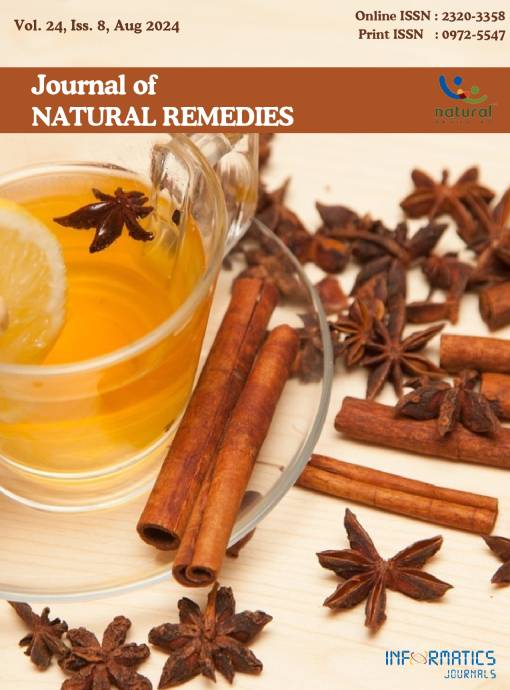Development and Optimisation of Olive Oil-infused Emulgel from Andrographis Extract Using Quality by Design (QbD) Methodology
DOI:
https://doi.org/10.18311/jnr/2024/36591Keywords:
Andrographolide, Characterisation, Emulgel, QbD, ResponsesAbstract
Background: Andrographolide, the primary active constituent in Andrographis extract, exhibits poor aqueous solubility, necessitating a novel formulation strategy for effective dermal delivery. Aim: To formulate and optimise olive oil-infused emulgel from Andrographis extract. Methods: Various emulgel formulations were prepared using different combinations of oil and Carbopol 940. The formulations were assessed for visual inspection, pH, spreading ability, extrudability, viscosity, drug content, and in vitro drug release. The optimal formulation (AEE 6) was identified using design expert software based on the evaluated parameters. Results: The emulgel formulations demonstrated varied properties based on the combinations of oil and Carbopol 940 used. The optimized formulation (AEE 6) showed favourable stability under accelerated conditions, maintaining stability across all assessed physicochemical parameters. Conclusion: The emulgel formulation approach successfully addressed the poor aqueous solubility of andrographolide, enhancing its permeation for dermal delivery. The selected formulation (AEE 6) demonstrated optimal characteristics and stability, making it a promising candidate for effective dermal delivery of Andrographis extract.
Downloads
Metrics
Published
How to Cite
License
Copyright (c) 2024 N V L SIRISHA MULUKURI, Pankaj Kumar, prabhakar T, sateesh Madav, Kusum devi (Author)

This work is licensed under a Creative Commons Attribution 4.0 International License.
Accepted 2024-07-09
Published 2024-08-31
References
Vetvicka V, Vannucci L. Biological properties of andrographolide, an active ingredient of Andrographis paniculata: A narrative review. Ann Transl Med. 2021; 9(14). https://doi.org/10.21037/atm-20-7830
Rajagopal S, Kumar RA, Deevi DS, Satyanarayana C, Rajagopalan R. Andrographolide, a potential cancer therapeutic agent isolated from Andrographis paniculata. J Exp Ther Oncol. 2003; 3(3):147-158. http://doi.org/10.1046/ j.1359-4117.2003.01090.x.
Islam MT, Ali ES, Uddin SJ, Islam MA, Shaw S, Khan IN, et al. Andrographolide, a diterpene lactone from Andrographis paniculata and its therapeutic promises in cancer. Cancer Lett. 2018; 420:129-145. https://doi.org/10.1016/j.canlet.2018.01.074
Dai Y, Chen SR, Chai L, Zhao J, Wang Y, Wang Y. Overview of pharmacological activities of Andrographis paniculata and its major compound andrographolide. Crit Rev Food Sci Nutr. 2019; 59(1):S17-S29. https://doi.org/10.1080/1040 8398.2018.1501657
Mulukuri NVLS, Kumar P, Madhav NVS, Kusumdevi V, Nagajyothi N. An insight review on andrographolide from the king of bitters and its therapeutic potential for skin cancer and cosmeceutical applications. Ann. Phytomed. 2021; 10(2):280-285. https://doi.org/10.21276/ ap.2021.10.2.37
Indrati O, Martien R, Rohman A, Nugroho AK. Development of nanoemulsion-based hydrogel containing andrographolide: Physical properties and stability evaluation. J Pharm Bioallied Sci. 2020; 12(2):S816-S820. https://doi.org/10.4103/jpbs.jpbs_174_20
Corredor-Chaparro MY, Vargas-Riveros D, MoraHuertas CE. Hypromellose-collagen hydrogels/sesame oil organogel based bigels as controlled drug delivery systems. J Drug Deliv Sci Technol. 2022; 75:103637. https://doi.org/10.1016/j.jddst.2022.103637
Aiyalu R, Govindarjan A, Ramasamy A. Formulation and evaluation of topical herbal gel for the treatment of arthritis in animal model. Braz J Pharm Sci. 2016; 52(3):493-507. https://doi.org/10.1590/S1984-82502016000300015
Hazra M, Mandal DD, Mandal T, Rao BP, Samaddar S. Optimization and characterization of hepatoprotective andrographolide microspheres in the necrotic rat model. J Drug Deliv Sci Technol. 2021; 65:102679. https://doi.org/10.1016/j.jddst.2021.102679
Al Hoque A, Dutta D, Paul B, Kumari L, Ehsan I, Dhara M, et al. ΔPSap4# 5 surface-functionalized abiraterone-loaded nanoparticle successfully inhibits carcinogen-induced prostate cancer in mice: A mechanistic investigation. Cancer Nanotechnol. 2023; 14(1):73. https://doi.org/10.1186/ s12645-023-00223-5
Hernandez-Giottonini KY, Rodriguez-Cordova RJ, GutierrezValenzuela CA, Penunuri-Miranda O, Zavala-Rivera P, Guerrero-German P, Lucero-Acuna A. PLGA nanoparticle preparations by emulsification and nanoprecipitation techniques: Effects of formulation parameters. RSC Adv. 2020; 10(8):4218-4231. https://doi.org/10.1039/c9ra10857b
Khan BA, Ahmad N, Alqahtani A, Baloch R, Rehman AU, Khan MK. Formulation development of pharmaceutical nanoemulgel for transdermal delivery of feboxostat: Physical characterization and in-vivo evaluation. Eur J Pharm Sci. 2023; 195:106665. https://doi.org/10.1016/j.ejps.2023.106665
Malavi S, Kumbhar P, Manjappa A, Chopade S, Patil O, Kataria U, et al. Topical emulgel: Basic considerations in development and advanced research. Indian J Pharm Sci. 2022; 84 (5):1105-1115. http://doi.org/10.36468/ pharmaceutical-sciences.1005
Mulukuri NVLS, Dhara M, Gupta D, Devi K, Kumar P. Development and optimization of novel emulgel loaded with andrographolide-rich extract and sesame oil using quality by design approach: In-silico and in-vitro cytotoxic evaluation against A431 cells. Gels. 2023; 9(7):507. https:// doi.org/10.3390/gels9070507
Mwangi AN, Njogu PM, Maru SM, Njuguna NM, Njaria PM, Kiriiri GK, et al. Meloxicam emulgels for topical management of rheumatism: Formulation development, in vitro and in vivo characterization. Saudi Pharm J. 2021; 29(4):351-360. https://doi.org/10.1016/j.jsps.2021.03.005
Nagaraja S, Basavarajappa GM, Attimarad M, Pund S. Topical nanoemulgel for the treatment of skin cancer: Proof-of-technology. Pharmaceutics. 2021; 13(6):902. https://doi.org/10.3390/pharmaceutics13060902
Nikumbh KV, Sevankar SG, Patil MP. Formulation development, in vitro and in vivo evaluation of microemulsionbased gel loaded with ketoprofen. Drug Deliv. 2015; 22(4):509515. https://doi.org/10.3109/10717544.2013.859186
Pan H, Xu X, Qian Z, Cheng H, Shen X, Chen S, et al. Xanthan gum-assisted fabrication of stable emulsion-based oleogel structured with gelatin and proanthocyanidins. Food Hydrocoll. 2021; 115:106596. https://doi.org/10.1016/j.foodhyd.2021.106596
Patel BM, Kuchekar AB, Pawar SR. Emulgel approach to formulation development: A review. Biosci Biotechnol Res Asia. 2021; 18(3):459-465. https://doi.org/10.13005/bbra/2931
Rompicherla NC, Joshi P, Shetty A, Sudhakar K, Amin HIM, Mishra Y, et al. Design, formulation, and evaluation of Aloe vera gel-based capsaicin transemulgel for osteoarthritis. Pharmaceutics. 2022; 14(9):1812. https://doi.org/10.3390/pharmaceutics14091812
Said Dos Santos R, Vecchi CF, Rosseto HC, Bassi da Silva J, Dano ME, Castro-Hoshino LV, et al. Emulgels containing carbopol 934P and different vegetable oils for topical propolis delivery: Bioadhesion, drug release profile, and exvivo skin permeation studies. AAPS Pharm Sci Tech. 2020; 21(6):209. https://doi.org/10.1208/s12249-020-01748-3
Shah HS, Gotecha A, Jetha D, Rajput A, Bariya A, Panchal S, et al. Gamma oryzanol niosomal gel for skin cancer: Formulation and optimization using quality by design (QbD) approach. AAPS Open. 2021; 7:9. https://doi.org/10.1186/s41120-021-00041-2
Shah RS. Formulation and evaluation of turmeric emulgel. AJP Tech. 2021; 11(3):213-219. https://doi.org/10.52711/2231-5713.2021.00035

 N. V. L. Sirisha Mulukuri
N. V. L. Sirisha Mulukuri









 0.35
0.35 24
24 0.161
0.161